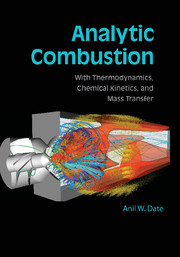Book contents
- Frontmatter
- Contents
- Preface
- Symbols and Acronyms
- 1 Introduction
- 2 Thermodynamics of a Pure Substance
- 3 Thermodynamics of Gaseous Mixtures
- 4 Chemical Equilibrium
- 5 Chemical Kinetics
- 6 Derivation of Transport Equations
- 7 Thermochemical Reactors
- 8 Premixed Flames
- 9 Diffusion Flames
- 10 Combustion of Particles and Droplets
- 11 Combustion Applications
- APPENDIX A Thermochemistry Data
- APPENDIX B Curve-Fit Coefficients for Δhc, Tad, Kp, Cp, h, and s
- APPENDIX C Properties of Fuels
- APPENDIX D Thermophysical and Transport Properties of Gases
- APPENDIX E Atmospheric Data
- APPENDIX F Binary Diffusion Coefficients at 1 atm and T = 300K
- Bibliography
- Index
10 - Combustion of Particles and Droplets
- Frontmatter
- Contents
- Preface
- Symbols and Acronyms
- 1 Introduction
- 2 Thermodynamics of a Pure Substance
- 3 Thermodynamics of Gaseous Mixtures
- 4 Chemical Equilibrium
- 5 Chemical Kinetics
- 6 Derivation of Transport Equations
- 7 Thermochemical Reactors
- 8 Premixed Flames
- 9 Diffusion Flames
- 10 Combustion of Particles and Droplets
- 11 Combustion Applications
- APPENDIX A Thermochemistry Data
- APPENDIX B Curve-Fit Coefficients for Δhc, Tad, Kp, Cp, h, and s
- APPENDIX C Properties of Fuels
- APPENDIX D Thermophysical and Transport Properties of Gases
- APPENDIX E Atmospheric Data
- APPENDIX F Binary Diffusion Coefficients at 1 atm and T = 300K
- Bibliography
- Index
Summary
Introduction
So far we have been concerned with combustion of gaseous fuels. However, solid (coal, wood, agricultural residues, or metals) and liquid (Diesel, kerosene, ethanol, etc.) fuels are routinely used in a variety of applications. Such fuels burn at a relatively slow flux rate, expressed in kg/m2-s. To achieve high heat release rates (J/s), it becomes necessary to increase the surface area of the fuel. This is achieved by atomizing liquid fuels and by pulverizing solid fuels. Liquid fuel atomization is achieved by employing high-pressure fuel injectors. Pulverized solid fuel is achieved by crushing/grinding operations to obtain tiny particles (typical diameter < 250 µm, in case of coal). This operation becomes increasingly expensive as the size of the particles is reduced.
Solid fuels are burned in a wide variety of ways. The most primitive systems burn fuels (typically wooden logs) by placing them on the ground and replacing (or feeding) fuel intermittently in a batch mode. More advanced versions include a fixed grate, as shown in Figure 10.1(a). The combustion air is drawn in by natural convection and the air flow rate is controlled by dampers. Such systems are used in small furnaces or cookstoves. These systems were improved considerably in power generation applications by having a fixed (sloping) or traveling endless grate on which solid fuel is fed continuously via a stoker and the combustion air is supplied by means of a fan/blower.
- Type
- Chapter
- Information
- Analytic CombustionWith Thermodynamics, Chemical Kinetics and Mass Transfer, pp. 223 - 260Publisher: Cambridge University PressPrint publication year: 2011



